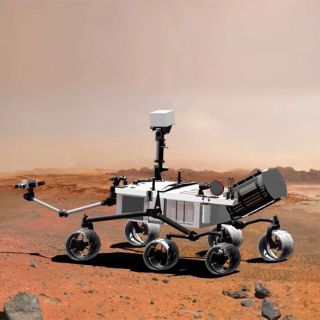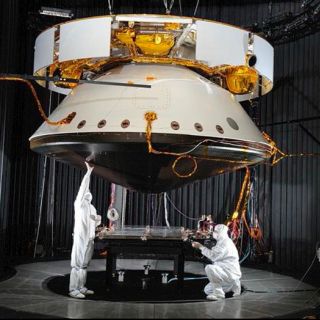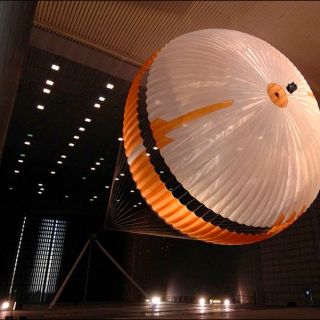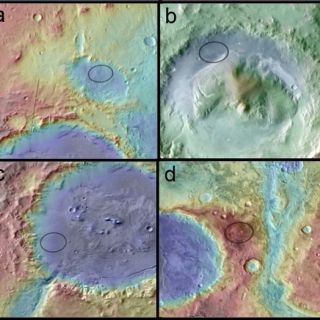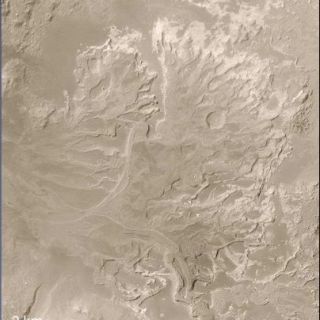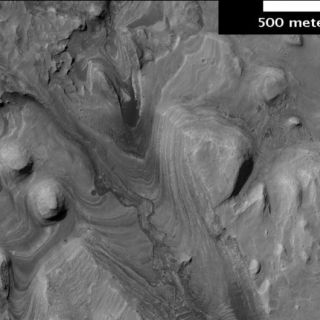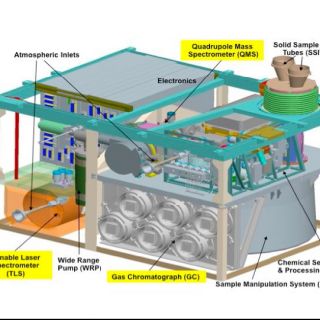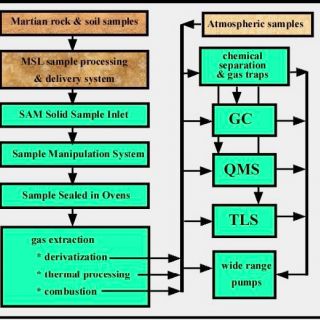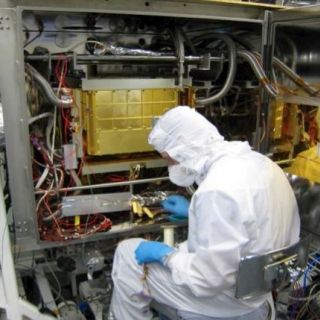by Paul Mahaffy
NASA Goddard Space Flight Center, Greenbelt, MD 20771
Mars provides one of the most accessible locations in our solar system outside Earth into geological and geochemical windows through which to view planetary evolution from billions of years in the past until the present. Successful missions in the past decade to both study Mars from orbit and to land on its surface have dramatically advanced our understanding of our neighboring cold but volatile-rich planet. Taking advantage of nearly every recent launch window that presents itself every 2.135 years the 'follow the water' theme has been vigorously pursued as a first exploration step most relevant to the driving question of the possibility of past or present microbial life on Mars. With this exploration directive, the global distribution of near surface water ice and hydrated minerals was mapped from orbit by NASA's Odyssey spacecraft (Boynton et al., 2002) using measurements of the energy distribution of cosmic ray generated neutrons produced from the near surface. High latitude regions were inferred to be typically composed of more than 50% water ice in the top tens of centimeters of soil. Hard on the heels of this discovery, the Mars Exploration Rovers Spirit and Opportunity found convincing evidence at mid latitudes but on opposite sides of the planet of aqueous alteration by liquid water (Squyres et al., 2004 and 2008). This evidence came in the form of minerals (jarosite, goethite, and opaline silica) formed by aqueous transformation and also in the form of signatures of water flow revealed in returned images of cross-bedding in sedimentary layers from the rover cameras. The Phoenix high latitude lander mission (Smith et al., 2009) trenched down through surface soil to an icy layer and provided ground verification of the Odyssey measurement. More recent observations from high resolution orbiting telescopes and imaging spectrometers (Murchie et al., 2009) have resulted in a better understanding of the surface transformations over the history of Mars by water, giant impacts, volcanoes, winds, and the large scale movement of surface ice caused by the periodic variations in the planet's axial tilt (its obliquity). Rich assemblages of phyllosilicates (clays) and hydrated mineral layers continue to be revealed in many locations by imaging spectrometers on both the European Mars Express Mission and NASA's Mars Reconnaissance Orbiter. An emerging paradigm now paints a picture of an early wetter Mars that enabled clay formation in a more neutral chemical environment than the following more acidic sulfur dominated surface environment produced by immense volcanic activity (Bibring et al., 2006). Exposure of ancient terrains and the lack of plate tectonics for much of the history of Mars suggest that geochemical windows into the distant past may be preserved in the near-surface so that future surface landers and rovers may be able to explore the environmental conditions necessary for life in ancient sites.
The Mars Science Laboratory (MSL) now planned to be sent on its way to Mars in the 2011 launch opportunity is designed to explore habitability with a large heavily instrumented rover. After landing, MSL will be able to traverse 10's of kilometers over the 2-year mission lifetime (one Mars year) and access specific sites that have been identified from orbit by imaging and spectroscopy measurements. The MSL primary science goals are (1) to assess the past or present biological potential at the targeted site, (2) to characterize the site's geology at various spatial scales, and (3) to investigate other planetary processes that influence habitability. The MSL mission moving beyond the 'follow the water' theme seeks an even more detailed understanding of the history of the Mars environment (Grotzinger, 2009) and how significant transitions in this environment might have impacted potential habitats for even the simplest microorganisms or even their chemical precursors.
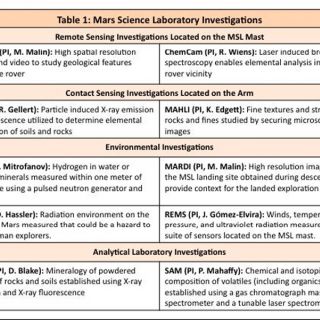 Table 1.
Table 1
Table 1.
Table 1
Dust storms on Mars are predicted to enhance the abundance of hydrogen peroxide in the atmosphere to the point where it accumulates on the surface (Atreya et al., 2006). A first order question for MSL is whether organic compounds produced by early or current biological processes, by abiotic processes, or even delivered from space by meteoritic infall can be preserved in what is likely to be this oxidizing surface environment. MSL will not only search for these organic compounds but will also inventory other chemical building blocks of life containing carbon, hydrogen, nitrogen, oxygen, phosphorus, and sulfur compounds. Regardless of the fate of ancient or recent reduced carbon compounds in the Martian soils and rocks the chemical processes that might destroy or preserve organic compounds must be understood and so MSL intends to study the geology and chemistry in detail to interpret processes that have formed and transformed rocks and regolith. Planetary process that impact habitability such as climate change and loss of a portion of the atmosphere over time will be explored by MSL by signatures of these processes in isotopic composition, particularly in the inert noble gases in the atmosphere. MSL will be launched in late 2011 on an Atlas V 541 rocket. Its entry, descent, and landing (EDL) through the thin atmosphere of Mars in the late summer or fall of 2012 will utilize first a heat shield to slow down the entry vehicle during a guided descent, then deployment of a large supersonic parachute followed by a powered descent, and finally tethered release of the MSL rover directly onto its wheels from the descent stage hovering several meters above the surface. This final sky crane touchdown system is intended to enable a soft landing for the ~900 kg rover since airbag technology of the type used to protect the MER landers after their release from their parachute is not suitable for this size vehicle. The nominal mission duration is one Mars year (2 Earth years) although an additional exploration period may be realized in an extended MSL mission. Figure 1 shows an artist's conception of MSL on the surface of Mars and Figure 2 a picture of the MSL spacecraft and aeroshell being prepared for tests in a thermal vacuum chamber. Figure 3 is a picture of the massive parachute being tested in a large wind tunnel.
The MSL science payload summarized in Table 1 enables four different types of scientific investigation. Using the high resolution mast camera (Mastcam) and a laserinduced breakdown spectrometer (LIBS or ChemCam) the geology and a rapid survey of chemical differences in targeted rocks in the immediate vicinity of the rover can be established. At the same time the neutron detector (DAN) provides information on the near subsurface abundance of water containing minerals. Once these tools identify an interesting site and specific rocks or soils the MSL arm is extended to allow a more detailed examination by a microscope (MAHLI) and an alpha particle X-ray spectrometer (APXS) that can establish elemental composition. Finally, samples of greatest interest are processed into powder by a rotary percussive drill/sieve system and delivered to two instruments in the interior of the rover. In these instruments the mineralogy of the sample can be established by an X-ray diffraction/X-ray fluorescence instrument (ChemMin) and the search for organics, inorganic volatiles, and the measurement of various isotopes will be carried out by a suite of instruments (SAM). The SAM science investigation, its instruments, and supporting technology is described in more detail below. Finally, atmospheric winds, temperatures, pressures, and ultra violet radiation are measured by an additional instrument in the mast (REMS), the energetic radiation environment of the type that could be hazardous to future human explorers is measured with the RAD instrument, and the geological context of the landing site is obtained by the descent camera MARDI.
The diversity of geology and mineralogy revealed by ongoing orbital tools provides an excellent set of tools to select a MSL landing site that can best address the mission's scientific goals. Several dozen proposed landing sites have been presently narrowed down to four through a series of open workshops that brought Mars scientists and MSL engineers together to discuss the relative merits of each site. In parallel with the development of the scientific motivation for landing at particular site, the practical issue of avoiding rocky terrains and extreme slopes was addressed and the altitude and winds at the landing site considered. Landing more than 1 km above the mean Mars altitude, for example, might not give the MSL entry system enough time in the atmosphere to robustly exercise its multiple deceleration modes so lower altitude sites are preferred. Fortunately, the four sites that were judged to be of extraordinary scientific interest appear to also provide the required safety factors for the MSL entry, descent, and landing (EDL) systems. Listed from North to South these are Mawrth Vallis, Gale Crater, Eberswalde Crater, and Holden Crater. Orbital images of these sites superimposed on a color coded map of altitude from the Mars Orbiter Laser Altimeter are shown in Figure 4 together with candidate landing ellipses that avoid much of the rocky or highly slopped terrain.
Two of the landing sites show clear evidence of the past presence of flowing water (Malin and Edgett, 2003). A well-defined delta (Figure 5) is present inside the Eberswalde Crater that could be reached through a rover traverse. Likewise, a reasonable explanation for features observed at the Holden Crater candidate-landing site is that ancient sedimentary deposits from a lake that formed in the crater were later exposed by a river that spilled over the walls of the crater from the south. The sediments in both these locations are compelling locations for the exploration of habitability with the MSL. Compelling spectroscopic features are among the factors that provide strong motivation for the in situ exploration of the Gale Crater and Mawrth Vallis candidate landing sites. A rich sequence of layered terrain with diverse spectroscopic signatures includes both clays and sulfates in the central mound of Gale crater (Figure 6). Slopes are gentle enough in some locations that these sites can be reached by an extended traverse from the smoother landing site. Mawrth Vallis shows some of the strongest and most diverse phyllosilicate signatures seen anywhere on the planet. This site is evidently from the early Noachian period of Mars with the spectral features more recently exposed by erosion processes. An attractive feature of the Mawrth Vallis site is that features of interest are found in the landing ellipse and can be accessed without a long traverse.
A 3 dimensional representation of the SAM suite of instruments and associated supporting subsystems is shown in Figure 7. The three instruments that measure either atmospheric gas or gas extracted from solid samples are a quadrupole mass spectrometer (QMS), a tunable laser spectrometer (TLS), and a gas chromatograph (GC). The six column GC not only has its own detectors, but also can operate together with the QMS as a gas chromatograph mass spectrometer (GCMS). The supporting systems are a Chemical Separation and Processing Laboratory (CSPL) and sample manipulation system (SMS). The manipulation of solid sample and the processing of gaseous samples in SAM is schematically illustrated in the block diagram of Figure 8. The SAM suite has been tested in an environmental chamber designed specifically for this instrument (Figure 9) where the temperatures and pressures encountered by the instrument can be set to those expected inside the rover on the surface of Mars.
The Mars atmosphere is sampled by SAM micro-valve operations that introduce a small volume of atmospheric gas through an inlet tube to the SAM instruments. This manifold gas volume is either introduced into the QMS through a capillary leak or directed to the TLS. Finely sieved solid phase materials delivered from the MSL rotary percussive drill to a SAM inlet funnel that delivers sample down a tube to one of 74 SAM sample cups. The funnel is vibrated during sample delivery to insure complete transfer to the cup. The cup is then inserted into a SAM oven and thermally processed to release volatiles. The gas processing manifold includes high conductance and micro valves, chemical and mechanical pumps, carrier gas reservoirs and pressure regulators, pressure monitors, the pyrolysis ovens, the chemical scrubbers and getters, and all the associated heaters and temperature sensors.
The quadrupole mass spectrometer can operate in static or dynamic mode with a mass range of 2-550 m/z. Its ion detector dynamic range >1010 with both a channeltron pulse counting electron multiplier and a Faraday Cup. The crosstalk between adjacent peaks is greater than one million which enables isotopes of interest to be accurately measured. The gas chromatograph utilizes on of six columns to separate a complex mixtures of organic compounds into its molecular components which are detected both by the mass spectrometer and the thermal conductivity detectors on 5 of the 6 columns. The GCMS detection limit exceeds the part per billion mission requirement for organic detection. The TLS is a two channel Herriott cell design spectrometer that provides detection of CH4, H2O, and CO2 and the isotope ratios 13C/12C, 18O/16O, and 17O/16O in carbon dioxide, D/H in water, and 13C/12C in methane. The TLS sensitivity for atmospheric gas is < 1 ppb and the detection limit can be substantially reduced by methane enrichment in SAM's CSPL.
A mixture of several calibration gases is brought to Mars in SAM to be used at regular intervals during the mission. The calibration gas cell includes N2, CO2, Ar, and a Xe mix that is heavily spiked with 129X to clearly distinguish it from terrestrial or martian xenon. Three fluorocarbon compounds are included in this cell to evaluate the performance of the GCMS before launch and over the course of the mission. An organic check material that processes the same fluorocarbons adsorbed on an inert silica glass matrix through the entire sample processing chain provides both a check on the performance of the SAM organics detection and the cleanliness of the sample transfer chain.
The first steps by the SAM suite to search for organics will be to heat a powdered sample of rock and analyze the evolved gas. This analysis is first implemented with rapid mass spectrometer scans as the sample is heated and a portion of the gas stream introduced through capillary leaks into the QMS. Subsequently a GCMS analysis of gas trapped from the evolved gas stream is carried out to enable a complex mix of organics, if present, to be separated into their individual constituents. The study of the source of organics will rely first of all on an examination of patterns such as molecular weight distribution, linearity or branched characteristics of hydrocarbons, and odd/even enhancements in chain length. Terrestrial biology leaves what are often such distinct patterns while extraction of carbon compounds from meteorites shows us that hydrocarbons produced and processed by abiotic processes in space exhibit more extensive branching and more randomized chemical structures. A second tool available to SAM for organics analysis will be carbon isotopic analysis. Refractory organics can be combusted to CO2 and their carbon and oxygen isotopes measured by the TLS. Comparisons of 13C/12C, for example, can then be made with these ratios in meteoritic carbon and with the isotopic composition of the oxidized carbon in the atmosphere.
Finally if a site rich in organics is identified samples can be analyzed in SAM utilizing one of the several chemical derivatization cells. In this experiment the foil sealing a metal cup is punctured and sample introduced to a liquid consisting of a mixture of the solvent DMF (dimethylformanide) and a derivatization agent MTBSTFA (N,N-Methyl-tert,-butl(dimethylsily)trifluoroacetamide). The silylation reaction that ensues turns polar molecules such as carboxylic acids and amino acids into non-polar volatile compounds that readily make their way through the GC column into the QMS. This extraction method has been utilized in our laboratory to analyze organics from samples of the highly oxidized, organic-poor soil from the driest part of the Atacama desert. This wet extraction method avoids the potential issues associated with the transformation by oxdation of these organic compounds during pyrolysis.
Localized methane has recently been identified by spectroscopy in the atmosphere of Mars (Formisano et al., 2004; Krasnopolsky et al., 2005; Mumma et al., 2009). What is just as exciting as the discovery itself is the observation of its rapid disappearance over a period of weeks or months (Mumma et al., 2009). The lifetime of methane in the Mars atmosphere is predicted to be more than 300 years and there is evidently a destruction mechanism that operates on a much faster timescale (Lefevre and Forget, 2009). The SAM TLS undertakes a sensitive search for atmospheric methane and its 13C isotope. Methane will also be enriched for the TLS measurements in the SAM gas processing system to improve the precision of the isotope measurement. Regular measurements over the course of the two-year landed mission will provide better temporal resolution than the presently sparse ground-based measurements. As extensive terrestrial field work has illustrated (Sherwood Lollar et al., 2006), a broad range of measurements will ultimately be required to definitively prove if the source of methane on Mars is biotic or produced abiotically by processes such as serpentization. Related experiments carried out by SAM that we expect will contribute to the study of the source of the methane are measurements of the mixing ratio of other trace hydrocarbons and isotope ratios such as D/H in water. These measurements will include atmospheric samples and gases released from surface rock and soil samples.
Regardless of outcome of the MSL/SAM search for organics, the SAM suite is expected to provide a wealth of data on the chemical and isotopic composition of the atmosphere and of volatiles in solid samples. Measurements of the SNC (Martian) meteorites combined with the 1976 Viking lander data indicate that D/H, 15N/14N, and 38Ar/36Ar are all fractionated and enriched in the heavier isotopes. A precise measurement of the major Xe isotopes could solidify the widely held belief that Mars is really the origin of the SNC meteorites. Assuming this is found to be the case, a better precision SAM measurement of atmospheric isotope ratios of the other noble gases and 15N/14N in nitrogen could help determine what portion of the SNC gas was trapped from the atmosphere during the impact melt event or represents components present in the solid when these fragments were ejected into space. Although the present Mars atmosphere is being removed by processes such as solar wind sputtering, photo dissociation, and dissociative recombination of species such as N2+ with electrons it is not yet clear what the Mars composition and atmospheric pressure was more than 3.5 billion years ago when liquid water was probably much more prevalent and left its mark in the features seen in Eberswalde and Holden craters. Better measurements of carbon, nitrogen, hydrogen, oxygen, and noble gas isotopes with SAM will provide improved constraints on models of atmospheric loss over the history of the planet. If MSL lands on ancient terrain a comparison of these light isotopes in ancient rocks compared with the present atmosphere will give additional constrains on these models of atmospheric evolution.
MSL has the range of analytical tools to search for windows that could preserve evidence of the nature of ancient environments. Exploration at the MSL landing site is not limited to the search for organic compounds, but is planned as a systematic in situ examination of geomorphology, microscopy, mineralogy, chemistry, and isotopes over an extended area on the surface of Mars where hypotheses regarding habitability and geological processes can be tested with multiple experiments in diverse locations. The in situ studies will be well supported by orbital imaging and spectroscopic data. We anticipate that the MSL investigations will provide a significant step forward in exploring the processes that have shaped Mars and in our understanding of the present or past biological potential of the selected landing environment.
References
Atreya, S.A. et al., (2006), Oxidant Enhancement in Martian Dust Devils and Storms: Implications for Life and Habitability, Astrobiology 6, 439-450.
Bibring, J.-P., et al. (2006), Global mineralogical and aqueous Mars history derived from OMEGA/Mars Express data, Science, 312, 400 - 404, doi:10.1126/science.1122659.
Boynton, W.V. et al. (2002), Distribution of Hydrogen in the Near-Surface of Mars: Evidence for Subsurface Ice Deposits, Science Express 10.1126, 1073722.
Formisano V. et al. (2004), Detection of methane in the atmosphere of Mars, Science 306, 1758-1761.
Grotzinger, J. (2009), Beyond water on Mars, Nature Geoscience 2, 1-3.
Krasnopolsky V. A., et al., (2005) Detection of methane in the martian atmosphere: Evidence for life?; Icarus, 172, 537-547.
Lefevre, F. and Forget, F. (2009), Observed variations of methane on Mars unexplained by known atmospheric chemistry and physics, Nature 460, 720-723.
Malin, M.C. and Edgett, K.S. (2003), Evidence for persistent flow and aqueous sedimentation on early Mars, Science, 302, 1931-1934.
Mumma M. J. et al. (2009), Strong release of methane on Mars in northern summer 2003, Science, 323, 1041-1045.
Murchie, S.L. et al. (2009), A synthesis of Martian aqueous mineralogy after 1 Mars year of observations from the Mars Reconnaissance Orbiter, Journal of Geophysical Research, 114, E00D06, doi:10.1029/2009JE003342.
Sherwood Lollar, B. (2006), Unravelling abiogenic and biogenic sources of methane in the Earth's deep subsurface, Chemical Geology 226, 328-339.
Smith, P. (2009), H2O at the Phoenix landing site, Science 325, 58-61.
Squyres, S.W. et al. (2008) Detection of silica-rich deposits on Mars. Science 320, 1063-1067.
Squyres, S.W. and 49 CoAuthors (2004), The Opportunity Rover's Athena Science Investigation at Meridiani Planum, Mars, Science 306, 1698-1703.
Figure Captions
Figure 1. An artist's conception of the MSL rover on the surface of Mars. MSL is able to carry a much more substantial payload to the surface of Mars than any other previous Mars lander.
Figure 2. The aeroshell that will protect the MSL lander during the first stages of the entry into the Mars atmosphere is shown in an environmental test chamber.
Figure 3. The parachute design that will be utilized during the descent is tested in a large wind tunnel.
Figure 4. The 4 prime candidate MSL landing sites are shown with the color in these orbital images showing elevation. The sites are (a) Eberswalde Crater, (b) Gale Crater, (c) Holden Crater, and (d) Mawrth Valles. Landing ellipses of approximately 20 km are shown that avoid areas of high slopes or areas cluttered with large rocks.
Figure 5. The Eberswalde delta features are clearly evident in this image from space (Image: Malin Space Sciences/NASA/JPL).
Figure 6. Gale crater shows multiple layers in this high resolution image from the Mars Reconnaissance Orbiter (Image: NASA/JPL/University of Arizona).
Figure 7. A three dimensional model of SAM shows the instruments and major subsystems.
Figure 8. The SAM sample processing flow is illustrated for both transfer of solid and gaseous samples.
Figure 9. The SAM suite is here being prepared for tests in its environmental chamber that span the range of temperatures and pressures that SAM will encounter on the surface of Mars.
